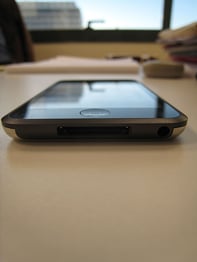Published on
Defining Instructional Technology: Key to Differentiation and Growth for Small Institutions

For years, Information Technology (IT) and Instructional Technology were misconstrued as synonyms. The assumption was that an IT professional could seamlessly integrate technology into the classroom without the need to know anything about pedagogy. After all, the professor was the keeper of pedagogy and all the software had to do was what they told it to do. This also applied to the technician, seen largely as a worker bee and not a partner, and created frustration on both sides when the hardware or software tool did not live up to expectations.
While the above description may still be the norm in some cases, many more colleges and universities are recognizing the need for a new approach to dealing with technological innovation. This is either called instructional or educational technology. While there are different ideas as to what constitutes educational technology, one prominent definition is “the study and ethical practice of facilitating learning and improving performance by creating, using, and managing appropriate technological processes and resources” (Association for Educational Communications and Technology Definition of Terminology Committee 2012, 1). Some of the keys to this definition include “study” and “appropriate technological processes and resources.” Understanding when to effectively use technology necessitates knowledge of the teaching and learning process as well as different software and hardware tools.
The constant interplay between pedagogy and technology illustrates the need for enhanced negotiation and interpersonal communication skills. The instructional technologist not only needs to know how and when to incorporate technology, but also when to avoid the temptation to chase the new shiny piece of technology without a strong foundation for pedagogically purposeful use. This may include finding ways to foster frank and open discussions with faculty and IT departments about the more fundamental pedagogical goals they are attempting to achieve. Instructional technologists can have these conversations largely because of foundational knowledge of both pedagogy and information technology.
The wave of technology and increasing demand by both students and graduates is forcing faculty and department chairs to increase innovation and introduce new ways in which to incorporate instructional technologies (Demuth 2010). An argument can be made that there is an almost seamless nature to technological innovation. Students are no longer beholden to traditional concepts of time or limited to the use of library catalogues; in the modern world, contact and access to faculty can be instantaneous in many circumstances and faculty must adjust to this changing landscape (Demuth 2010). In order to do so, instructional technologists can be valuable partners to increase faculty and student engagement without undermining the role of personal relationships in the residential liberal arts setting.
One study illustrated that over 98 percent of all university students own both cell phones and either a laptop or desktop computer (Zhang 2009). Furthermore, institutions of higher learning continue to invest heavily in technological development and innovation. Included in this infrastructure improvement is the use of innovative LMS programs and other learning technologies (Zhang 2009). While is it imperative not to downplay the importance of these new technologies, it is also worth noting that they cannot replace all instructor-led components in the learning environment (Zhang 2009). Understanding how to successfully integrate technology requires the inclusion of the various stakeholder groups and a coalition that can help to define the vision of what the new construct will look like (Black and Gregersen 2008, Kotter 1996) and create a sense of urgency (Kotter 2008) that will drive participation in the process (Black and Gregersen 1997, Black and Margulies 1989).
Academically excellent, independent liberal arts colleges (such as those represented by the ACM) that take great pride in offering a high level of faculty and student engagement. The small faculty-to-student ratios are only the beginning. Faculty and students build relationships that last a lifetime. To this end, liberal arts colleges see a tremendous opportunity to impact teaching and learning in a very positive way with technology. Technology is not seen as a replacement for the faculty member, but rather an enhancement that can be incorporated to create a deeper level of understanding surrounding the teaching and learning process.
The landscape of higher education is becoming more technologically diverse with each passing day. With cuts in state funding for education allowing small liberal arts colleges to become even more competitive with public universities and colleges, it is very important to stand out. Integrating technology in a sound pedagogical way allows residential liberal arts campuses to show value in ways that many large research universities cannot. For example, combining low student-to-faculty ratios with the insights instructional technologies provide into how students engage with course content and materials allows both students and faculty members to focus instruction in a way that can be virtually impossible in a class of hundreds. This synthesis of individualized instruction, critical thinking, and technological advancement allows for an enhanced learner-centered approach to teaching and learning.
In order to facilitate the integration of technology and pedagogy, ACM campuses either have or are in the process of identifying instructional technology structures to partner with faculty members to enhance current and future course offerings. In addition to the various campus resources, the ACM has created a Liaison for Technology in Teaching and Learning position through a grant from the Andrew Mellon Foundation to increase communication within the consortium. If the goal of a technologist on a campus is to match technology to pedagogy, the role of the consortium-wide position is to match professors, technologists, librarians and IT professionals with others using technology and pedagogy in similar or complimentary ways.
Creating connections between consortial members can take many forms. This includes in-person meetings with faculty, technologists, librarians, and IT staff; seminars and workshops dealing with various instructional technology issues and tools; the creation of blogs, websites, and groups that foster greater communication and collaboration; and fostering professional development opportunities through grant opportunities. Working to build relationships and enhance communication between different stakeholder groups (i.e. faculty, librarians, technologists, and IT professionals) is at the heart of instructional technology. After all, instructional technology is not about the tool, but about how a specific tool can enhance the learning experience. This is a crucial distinction for higher education moving forward.
– – – –
References
Association for Educational Communications and Technology Definition of Terminology Committee. 2012. Definition of terminology committee summer report. Bloomington, IN: Association for Educational Communications and Technology.
Black, James Stewart, and Hal B. Gregersen. 1997. Participative decision-making: An integration of multiple dimensions. Human Relations 50 (7): 859-878.
Black, James Stewart, and Hal B. Gregersen. 2008. It starts with one: Changing individuals changes organizations. 2nd ed. Upper Saddle River, N.J.: Wharton School Pub.
Black, James Stewart, and Newton Margulies. 1989. An ideological perspective on participation. Journal of Organizational Change Management 2 (1): 13.
Demuth, Leroy G., III. 2010. “Accepting technology as a solution: A quantitative study investigating the adoption of technology at colleges.”Doctoral dissertation, School of Business and Technology, ProQuest Dissertations and Theses database. (3402090).
Kotter, John. 1996. Leading change. Boston, Mass.: Harvard Business School Press.
Kotter, John. 2008. A sense of urgency. Boston, Mass.: Harvard Business Press.
Zhang, H. 2009. “Towards blended learning: Educational technology to improve and assess teaching and learning.”Doctoral dissertation, ProQuest Dissertations and Theses database. (3371698).
Author Perspective: Association



